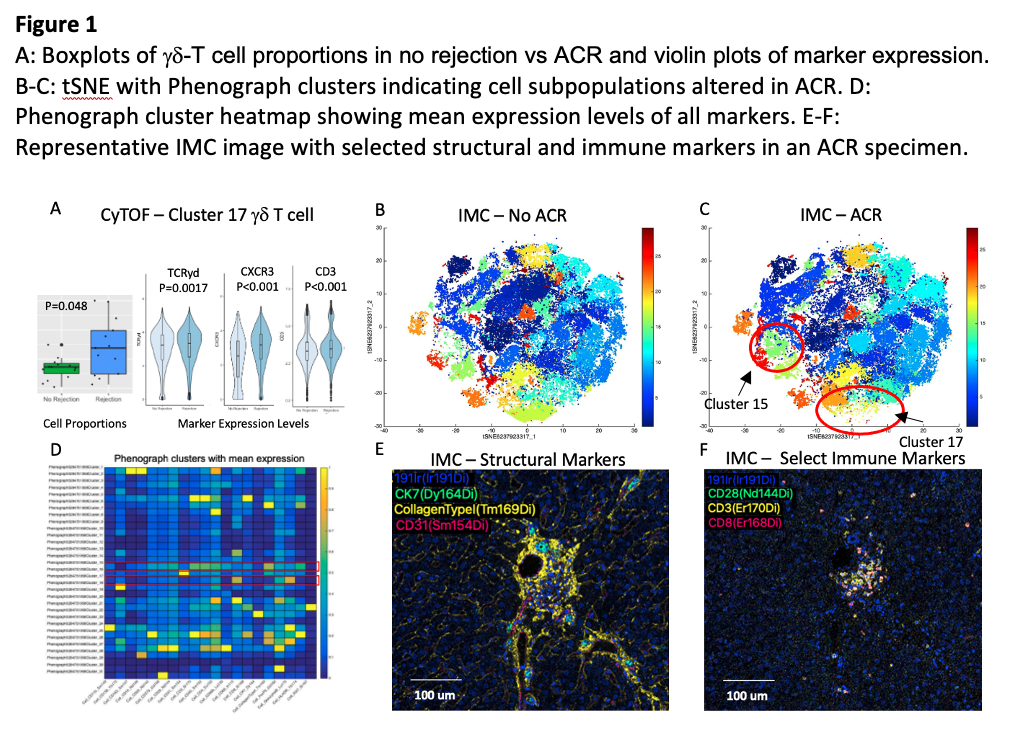Single Cell Multiomics Reveals Immune Mediators in Acute Cellular Rejection Following Pediatric Liver Transplantation
1University of Southern California Keck School of Medicine, Los Angeles, CA, 2Keck School of Medicine of University of Southern California, Pasadena, CA, 3Surgery, abdominal transplat, University of Southern California, Los Angeles, CA, 4Keck School of Medicine of USC, Los Angeles, CA, 5Childrens Hospital Los Angeles, Los Angeles, CA, 6University of Southern California, Los Angeles, CA
Meeting: 2022 American Transplant Congress
Abstract number: 472
Keywords: Histology, Liver grafts, Rejection, T cell graft infiltration
Topic: Basic Science » Basic Science » 16 - Biomarkers: -omics and Systems Biology
Session Information
Session Name: Biomarkers: -omics and Systems Biology
Session Type: Rapid Fire Oral Abstract
Date: Tuesday, June 7, 2022
Session Time: 3:30pm-5:00pm
 Presentation Time: 3:30pm-3:40pm
Presentation Time: 3:30pm-3:40pm
Location: Hynes Room 304 / 306
*Purpose: Acute cellular rejection (ACR) is a common complication following pediatric liver transplantation with potential negative effects on allograft longevity. Currently, diagnosis and management are based on invasive biopsies prompted by transaminitis which is clinically unreliable. There have been very few, small studies of multiplexed immune assays in liver transplantation to date and the mechanisms of ACR in patients is poorly understood. This study aimed to use multiomics to describe the immune landscape in both allograft tissue and blood of pediatric liver transplant recipients with ACR and to identify putative biomarkers of ACR.
*Methods: Thirty patients were recruited to the study (15 ACR [RAI>3/9], 15 No Rejection [RAI 0/9]) using 32 marker mass cytometry (CyTOF) and 23 marker imaging mass cytometry (IMC) to examine the immune profiles in peripheral blood mononuclear cells (PBMCs) and liver graft biopsy tissue respectively. Analyses were conducted in R and Histocat.
*Results: CyTOF analysis of over 370,000 live PBMCs demonstrated subtle differences in circulating immune subpopulations between ACR and no rejection. Most notably, a γδ-T cell subpopulation was expanded in ACR vs no rejection with higher expression of TCRγδ, CD3, and CXCR3 (p<0.01, Figure 1A). IMC analysis of biopsies showed that acute cellular rejection has an expansion of CD28-expressing T cells in ACR which may reflect the γδ-T cell subset seen peripherally (Figure 1 B-D). Neighborhood analysis revealed that the expanded T cell population interacts primarily with CD8+ T cells and collagen-expressing hepatic stellate cells. There was also depletion of CD68+/GranzymeB+ Kupffer cells and a marked expansion of CD66b+ granulocytes during ACR, but further CD28+ T cell clusters were unaffected.
*Conclusions: This is the first multiomics analysis of ACR in pediatric liver transplantation and although differences between circulating leukocytes are subtle, they appear to reflect the tissue level immune landscape yielding potential targets for a non-invasive diagnostic assay.
To cite this abstract in AMA style:
Rocque B, Sarode D, Barbetta A, Singh P, Goldbeck C, Weaver C, Akbari O, Kohli R, Emamaullee J. Single Cell Multiomics Reveals Immune Mediators in Acute Cellular Rejection Following Pediatric Liver Transplantation [abstract]. Am J Transplant. 2022; 22 (suppl 3). https://atcmeetingabstracts.com/abstract/single-cell-multiomics-reveals-immune-mediators-in-acute-cellular-rejection-following-pediatric-liver-transplantation/. Accessed December 20, 2025.« Back to 2022 American Transplant Congress

